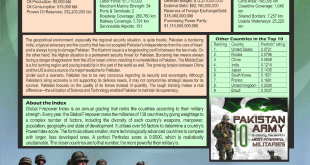Afghanistan, a war-torn country, yearns for peace. Life in Afghanistan has been paralyzed. Its economy is in tatters – almost ninety percent of its GDP comes from foreign funding. Unemployment ratio is skyrocketing as almost fifty percent of its population is unemployed.
In Afghanistan, suicide bombings, bloodshed and massacre of innocent people have become rampant. The Taliban and al-Qaeda have ruined the country. Now Islamic State (IS), a lethal militant group, is trying to gain influence in Afghanistan. Unfortunately, the physical features and the geostrategic position of the country suits to IS’s nefarious agenda and aims. In this sorry state of affairs, Afghanistan direly needs peace.
Hurdles to peace in Afghanistan
First, the Afghan Taliban are of the viewpoint that unless the foreign forces, especially those of the US, withdraw completely from Afghanistan, they would not make any peace treaty with the government in Kabul. Though a large chunk of NATO and the US troops withdrew in 2014, there still are 8,400 US troops on the soil of the country. The reason often cited for the presence of the US security forces is that they are assisting the untrained army of Afghanistan. The Taliban, a major perpetrator of destruction and bloodshed in Afghanistan, are sceptical of the presence of the forces as they abominate the US presence asserting that the US and its allies have occupied their land.
Second, ineffective border management between Afghanistan and Pakistan is a major impediment to garnering peace in Afghanistan. Durand line, the international border between the two countries, is 2640 kilometres long. And, there are about 235 entry/exit spots along the border. The militant groups move freely between both countries. For example, Haqqani Network attacks Kabul and hides itself in the border area of Pakistan. Similarly, Tehreek-i-Taliban (TTP) attacks Islamabad and takes sanctuary in bordering region of Afghanistan. Hence the porous border of Afghanistan and Pakistan provides safe havens to militant groups.
Third, proxy wars between and among regional countries like India, Iran and Pakistan also add to the devastation and destruction of Afghanistan. Some international and domestic geopolitical experts maintain that India supports Afghanistan’s National Directorate of Security (NDS) and the TTP only to destabilize Pakistan. Pakistan, on the other hand, asserts that almost all insurgency, particularly in Balochistan, is sponsored by the Indian intelligence agency RAW. Afghanistan openly alleges that Pakistan supports the Afghanistan Taliban. From this entire hullabaloo, it is crystal clear that Afghanistan’s neighbouring countries are involved in destabilizing not only Afghanistan but also the whole region.
Fourth, ethnic diversity and conflict in Afghanistan is another formidable obstacle in the way of bringing peace in Afghanistan. The country has a diverse ethnic profile with groups like Pashtuns, Tajiks, Uzbeks, Hazaras, so on. They almost always remain at daggers drawn – a fact highlighted further from the formation of the country’s National Unity Government. Every ethnic groups deems itself to be superior to other groups. Dependency even for common good is detested by them.
Fifth, Taliban abominate democracy. They see democracy as a Western form of government that is dead against the teachings of Islam. If Sharia is not enforced in Afghanistan, the Taliban would continue their Jihad (struggle) in that direction, they assert.
Prospects for peace in Afghanistan
Though the prospects for peace in Afghanistan are bleak, yet, as they say ‘every cloud has a silver lining, the situation seems moving in the right direction as more and more countries like China, Russia, US, Iran, India and Pakistan, and astonishingly even the Taliban, are involved in efforts for a peaceful Afghanistan.
China, which hitherto stayed away from the Afghan imbroglio, seems to have developed an interest in the country. It is especially so because Uighur militancy is increasingly becoming a formidable threat for China. Moreover, China has huge political and economic interests here as a stable Afghanistan is a gateway to Central Asia for its ambitious ‘One Belt, One Road’ initiative. China has, in recent years, invested huge sums of money in Afghanistan to exploit its mineral wealth.
On the other hand, Russia sees the growing stronghold of IS in Afghanistan as a serious threat to its security and sovereignty. Probably, it is the principal reason that has compelled Russia to be closer to the Taliban, its former arch-enemy. It is rightly said that there is no permanent friend or foe in international relations. However, some geopolitical analysts claim that Russia would use the Taliban as pressure group against America for its vested interests.
The United States, still a major stakeholder in a peaceful and stable Afghanistan, has been thinking to send more troops to the country. Just like the Vietnam War, the US has miserably failed in winning the war in Afghanistan and now it wants peace and stability returning to Afghanistan as it cannot bear more losses in this protracted conflict.
Pakistan, another stakeholder in this scenario, also covets for peace in Afghanistan because a peaceful Afghanistan is in the interest of Pakistan more than any other country. If peace comes in Afghanistan, Pakistan would also be peaceful. Growing militancy and terrorism in Pakistan is due to instability in Afghanistan.
Taliban want peace but on their own terms. Taliban and other militant groups have been fighting against each other but the rise and rise of IS is being deemed a big threat to the very existence of Taliban in Afghanistan. It is very difficult for the Taliban to fight simultaneously with the US forces, the Kabul government and the IS group. Therefore, the Taliban also crave for peace and it is due to this reason that a former warlord Gulbuddin Hekmatyar has recently come to terms with the Afghan government.
The people of Afghanistan do also yearn for peace. Thirty-five-year-long war in Afghanistan has exhausted and enervated the people of Afghanistan.
Peace in Afghanistan is not only helpful for development and stability of the region but also the whole world at large. International community has employed all means for the resolution of the Afghan conflict but all efforts have ended up in smoke. Let it be very clear, peace in Afghanistan is possible only when Afghanistan’s neighbours and other countries in this part of the world work collectively for common good i.e. peace and security of the region. Fortunately, with overtures from Pakistan, China, Russia and Iran, it can be seen that peace in Afghanistan is not that far.
By: Sattar Kingrani
 Jahangir's World Times First Comprehensive Magazine for students/teachers of competitive exams and general readers as well.
Jahangir's World Times First Comprehensive Magazine for students/teachers of competitive exams and general readers as well.



